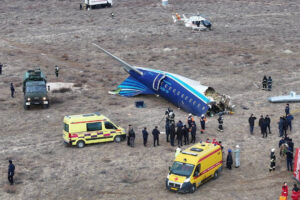Toronto, Frankfurt (16/9 – 30)
Derna is a second-tier city of roughly 100,000 people, situated in northeast Libya. Early dawn on Monday, September 11, two aging dams gave way, bursting and sending a seven-meter-high tsunami towards the city. Entire neighborhoods were washed into the sea.
The dams failed after heavy rainfall hit the region, as Storm Daniel passed through. Before passing over Libya, a Storm Daniel landfall in Greece resulted in 15 fatalities, on September 4. The same storm also wreaked havoc in Turkey and even up in Bulgaria. At least five people were killed after a flash flood swept through their campsite in Turkey’s Kirklareli province. After passing through the Mediterranean Basin, Storm Daniel slammed into the northern coast of Libya on September 9.
Libyan authorities have sealed off the flood-devastated port city of Derna from civilians, to allow emergency aid workers to restore services, amid concern that standing water contamination could add to the already horrific death toll. The flooding left at least 11,000 dead, according to official projections.
Derna is historically prone to flooding, and inadequate dam reservoirs have resulted in five deadly floods since 1942, the latest of which was in 2011, according to a research paper published by Libya’s Sebha University last year.
The two dams that burst on Monday were built around half a century ago, between 1973 and 1977, by a Yugoslav construction company. The Derna dam was 75 meters high with a storage capacity of 18 million cubic meters. The second dam, Mansour, was 45 meters high, holding 1.5 million cubic meters. The dams have had no maintenance since 2002, the city’s deputy mayor Ahmed Madroud told Al Jazeera.
Experts explain how apart from the strong storm, the Derna catastrophe was greatly exacerbated by a lethal confluence of factors, including aging, crumbling infrastructure, inadequate warnings and the impact of an accelerating climate crisis. Scientists believe that climate change is augmenting the intensity of extreme weather events like storms.
Warmer oceans provide fuel for storms to grow, and a warmer atmosphere can hold more moisture, meaning more extreme rainfall. Storms are becoming more ferocious because of climate change, said Hannah Cloke, professor of Hydrology at the University of Reading in the UK.
Meanwhile, Liz Stephens, Professor in Climate Risks and Resilience at the University of Reading in the United Kingdom, questioned the design standard of the dam and whether a risk of very extreme rainfall events had been taken into account. On the other hand, United Nations’ World Meteorological Organization Head Petteri Taalas expressed concern about the absence of alerts to warn citizens in Derna. Talaas added that the political instability in the country has impeded WMO efforts to work with the Libyan government to improve these systems.
This kind of catastrophe would have been much less likely during the Khaddafi regime, when huge sums of oil revenues were spent on modern infrastructure around the country. Libya was in the event too weak to resist the predations of NATO, eager to grab the oil, silver and gold that was to have backed a pan-African bank. Libya was the latest in a nation-smashing campaign that has brought misery to Iraq, Syria, Yemen, Afghanistan and Jordan. Today the country is broken into warlord-ruled territories, and a much-degraded standard of living for the average Libyan.
On the other side of the world, Hong Kong and cities across southern China are also battling flooding initiated by the heaviest rains in over 140 years, after Saola and Haikui, two full-force typhoons, hit southern China – and resulted in a citywide shutdown in Hong Kong. The Hong Kong Observatory issued a red rainstorm warning on Friday evening, September 15, the second such alert in two days.









